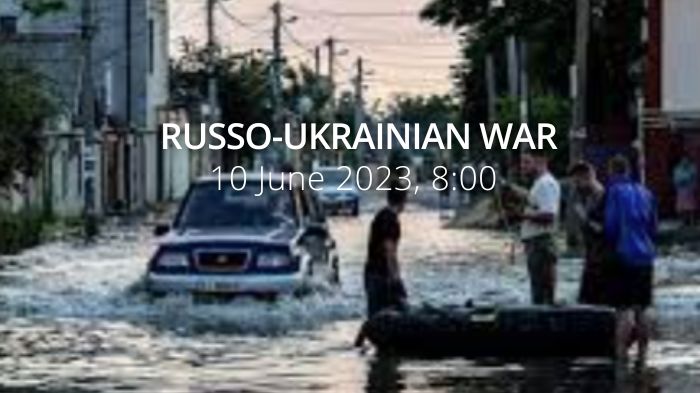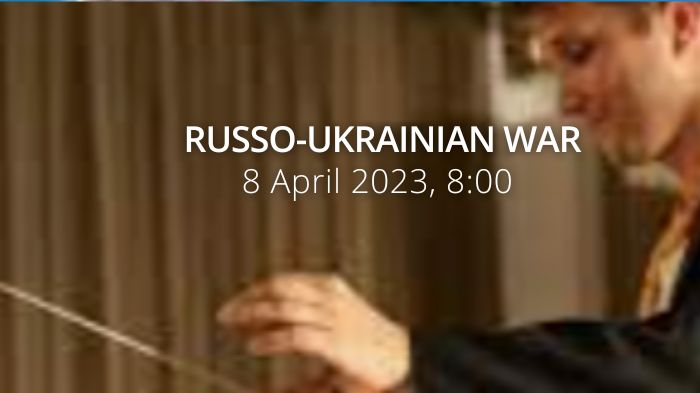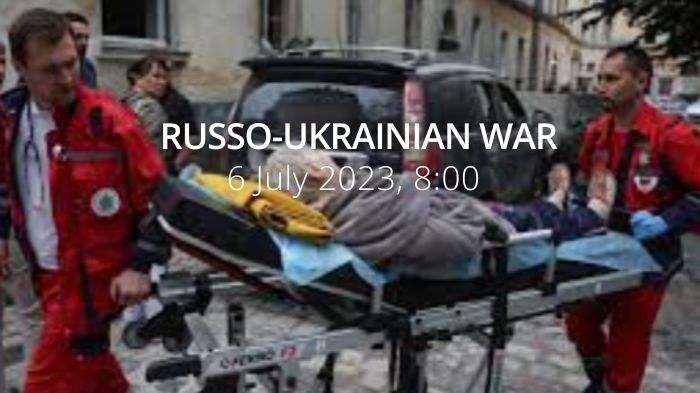Zelenskyy visits the US. $1.85 Billion in Additional Security Assistance for Ukraine. Putin and Russian Defense Minister Shoigu presided over a Russian Ministry of Defense Collegium in Moscow.
Daily overview — Summary report, December 22
Biden and Zelenskyy give joint press conference after holding 2 hours of closed talkshttps://t.co/hMF6xtDZ8I
— Euromaidan Press (@EuromaidanPress) December 21, 2022
A map of the approximate situation on the ground in Ukraine as of 00:00 UTC 22/12/22.
There have been no notable changes to control since the last update. pic.twitter.com/6909v3C9ZB
— War Mapper (@War_Mapper) December 22, 2022
The General Staff’s operational update regarding the Russian invasion as of 18.00 pm, December 22, 2022 is in the dropdown menu below:
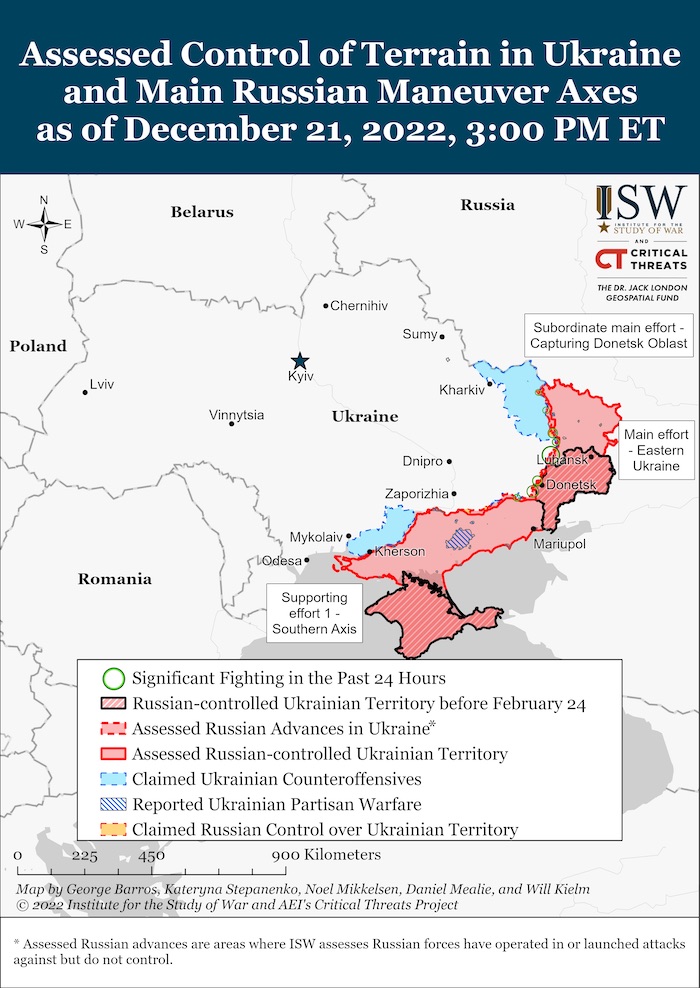
“[Russian forces continue to focus their effort on conducting offensive actions in the Bakhmut and Avdiivka directions and try to improve the tactical position in the Kupiansk and Lyman areas.]
To date, in almost 10 months, Russia has already lost more than 100,000 personnel, 3,000 tanks and about 6,000 other armoured vehicles in Ukraine.
Continuing the aggression, during the past day, Russian forces launched 6 missile and 15 air strikes, including on civilian objects in the Zaporizhzhia region. Also, Russian forces launched 64 MLRS attacks.
Over the past day, our soldiers repelled the attacks of the occupiers in the areas of the settlements of Novoselivske, Stelmakhivka, Ploshchanka and Chervonopivka in the Luhansk oblast and Berestove, Yakovlivka, Soledar, Bakhmut, Opytne, Kurdyumivka, Ozaryanivka, Mayorsk, New York, Krasnohorivka, Nevelske and Mariinka in Donetsk oblast.
In the Volyn, Polissya, Siverskyi and Slobozhanskyi directions, the situation has not changed significantly, and no signs of the formation of offensive groups of Russian forces have been detected. [Certain units of the armed forces of the Republic of Belarus and the Russian Federation continue to be located in the border areas with Ukraine.]
- At the same time, in the Siverskyi direction, Russian forces shelled the Zarutskyi district in the Sumy oblast with multiple rocket launchers.
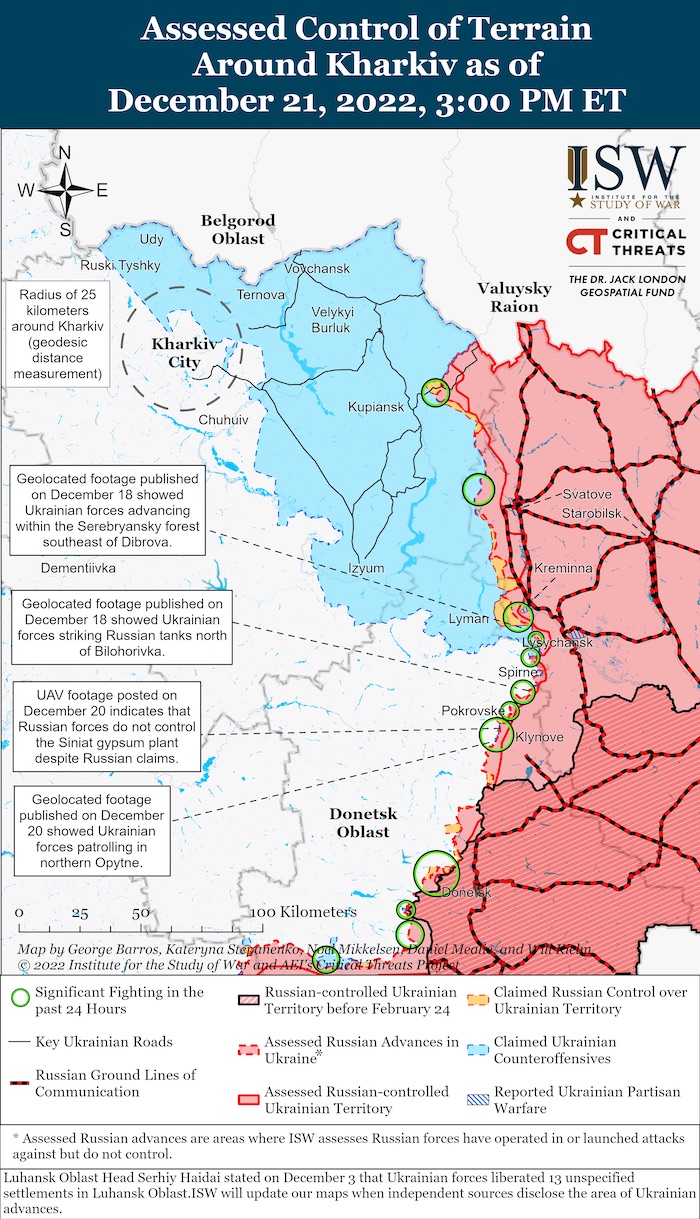
- In the Slobozhanskyi direction, areas of Chervona Zorya, Kozacha Lopan, Vesele, Varvarivka, Starytsa, Vovchansk, Vilcha, Chernyakiv, Chugunivka and Ambarne settlements of the Kharkiv oblast were hit by tank and artillery shelling.
- In the Kupiansk direction, Novomlynsk, Kupiansk, Kislivka, Kotlyarivka, Krokhmalne and Berestovka in the Kharkiv oblast and Novoselivske and Stelmakhivka in the Luhansk oblast came under fire.
- In the Lyman direction, shelling was recorded near Makiyivka, Ploshchanka, Nevske, Chervonopopivka, and Dibrova in the Luhansk oblast.
- In the Bakhmut direction, Russian forces fired from tanks and the entire range of artillery in the areas of the settlements of Verkhnokamyanske, Spirne, Bilohorivka, Yakovlivka, Soledar, Bakhmutske, Pidhorodne, Bakhmut, Opytne, Klishchiivka, Andriivka, Oleksandro-Shultine, Kurdyumivka, Diliivka, Ozaryanivka, Druzhba , Pivnichne, Mayorsk, Zalizne and New York of the Donetsk oblast.
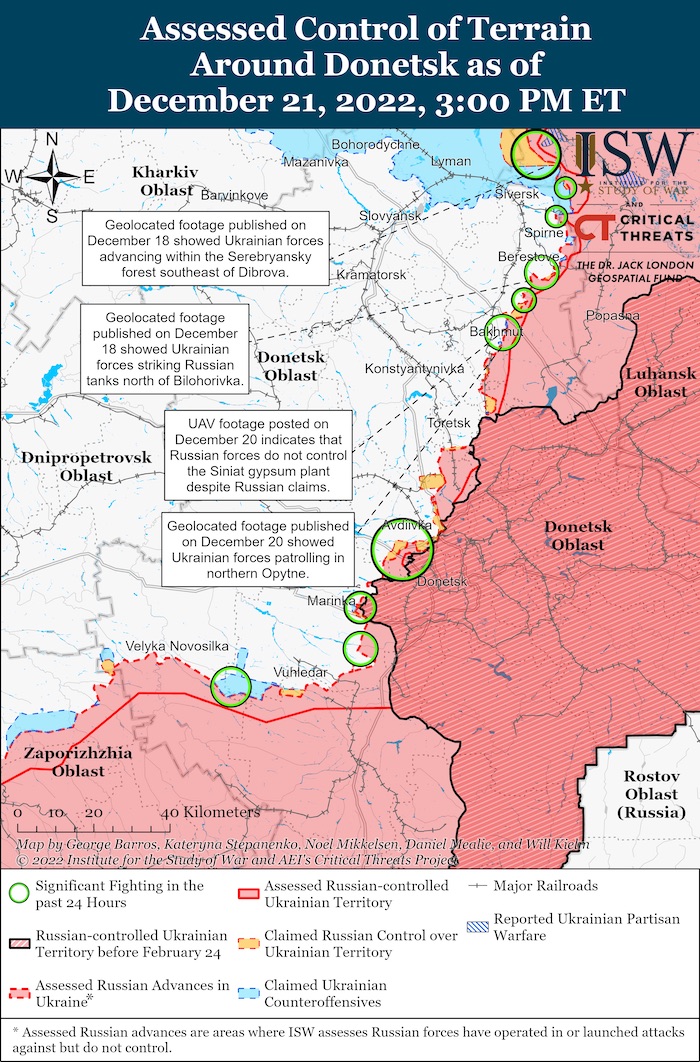
- In the Avdiivka direction, Krasnohorivka, Vesele, Vodyane, Pervomaiske, Nevelske, Mariinka and Novomykhailivka in Donetsk oblast were affected by fire.
- In the Novopavlivsk direction, Russian forces fired tanks and artillery of various calibres in the areas of Vuhledar, Prechystivka, Novoukrainka, and Velika Novosilka of the Donetsk oblast.
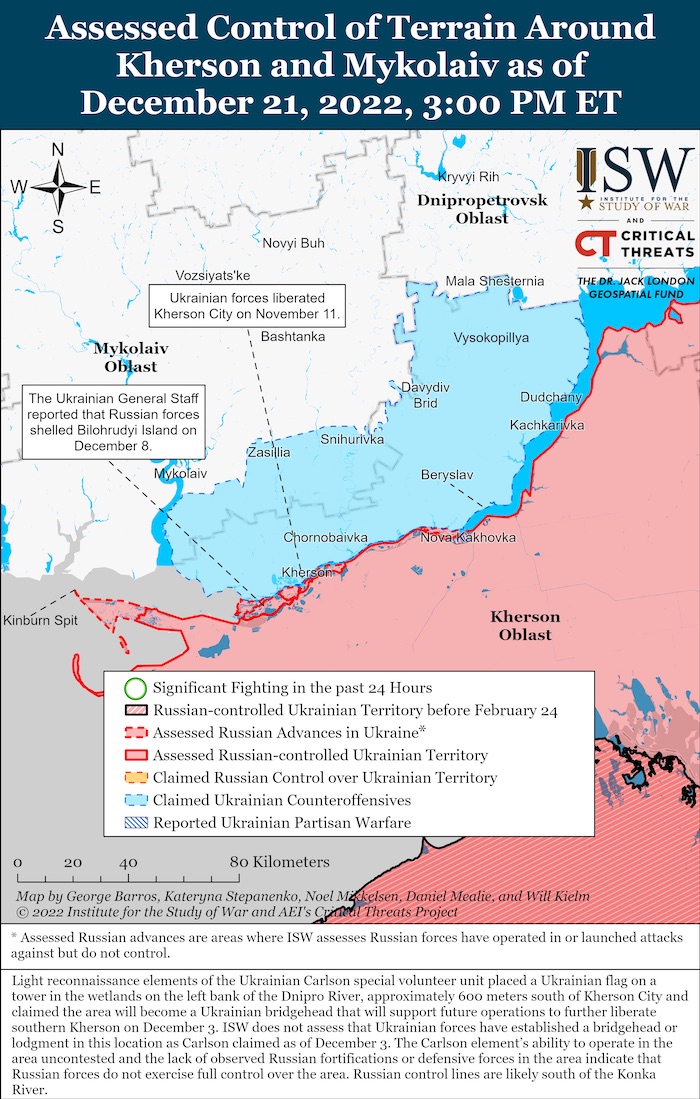
- On the Zaporizhzhia and Kherson directions, the settlement of Chervonohryhorivka of the Dnipropetrovsk oblast and the city of Kherson were hit by MLRS and artillery fire.
On December 17 of this year, a concentration of enemy personnel and equipment in the Horlivka area of the Donetsk oblast was confirmed to have been damaged by fire. There, 13 enemy servicemen were eliminated, 4 of whom were officers. An amphibious assault vehicle and 3 trucks with ammunition were also destroyed. Information about the wounded is being clarified.
[On December 15 and 16 of this year, enemy ammunition depots in the Kadiivka settlement of Luhansk oblast were damaged by fire. The detonation at these warehouses lasted more than 20 hours.]
[On December 20 of this year, the occupiers gathered at the field airfield in the Kakhovka district of the Kherson oblast suffered fire damage. There were about 30 units of artillery systems of various types, self-propelled guns and anti-aircraft guns, as well as ammunition and fuel and lubricants. Detailed information on the loss of equipment and personnel is being clarified.]
[The occupiers organized a field hospital in the village of Novobohdanivka, Zaporizhzhia oblast. In Novotroitske, in the Kherson oblast, the Russian invaders rebuilt the local hospital for the treatment of their wounded. Sick local residents were forcibly "discharged". In this settlement, the occupiers intensified counter-intelligence measures. All this indicates significant losses of Russian forces.]
In order to build fortifications in the Belgorod region, the local Russian leadership announced the recruitment of volunteers, for a monetary reward, for the arrangement of trenches and the installation of concrete cones.
During the past 24 hours, the Air Force of the Defense Forces carried out 14 strikes on the areas of concentration of personnel, weapons and military equipment of the occupiers. Also, our defenders shot down an enemy UAV of the "Forpost" type and two more - of the "Lancet-3" type.
At the same time, Ukrainian missile forces and artillery hit three control points and two areas where Russian forces's manpower was concentrated.”
Military Updates
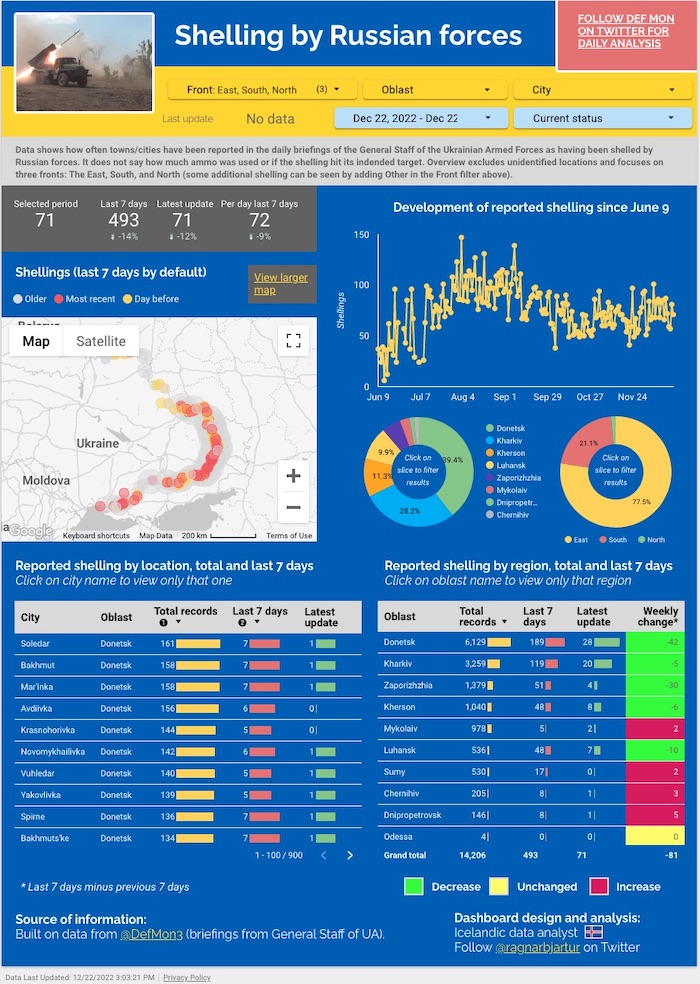
Ten Russian warships remain combat-ready in the Black Sea, Ukrinform reports, citing the Ukrainian Navy. “In the Black Sea, up to 10 Russian warships are remaining combat ready. In the Sea of Azov, Russian forces continue to control maritime communications, keeping up to two warships combat-ready.
In the Mediterranean Sea, there are nine Russian warships, including five Kalibr-type cruise missile carriers with a total volley of 72 missiles.”
Will American Patriot missile systems help Ukraine close the sky?
The short answer is: it depends. https://t.co/o5sWvbCBZc pic.twitter.com/F899rSzYT4
— Euromaidan Press (@EuromaidanPress) December 21, 2022
According to British Defence Intelligence, (last 48 hours):
https://twitter.com/DefenceHQ/status/1605904909760532480
- On 19 December 2022, President Putin travelled to Minsk to hold talks with President Lukashenka of Belarus. The presidents’ discussion included talk of a ‘single defence space’.
- Although Russia and Belarus prominently publicise Russian units’ deployments into Belarus, the armed forces of Belarus have likely recently taken on a significant, but more discreet role in training thousands of newly mobilised Russian reservists.
- The likely use of Belarusian instructors is an attempt to partially remediate the lack of Russian military trainers, many of whom are deployed in Ukraine or have become casualties. Although Russia and Belarus have an extensive background of military co-operation, the training of mobilised Russian personnel by Belarusians represents a role reversal. Belarusian forces have traditionally been considered by Russia as inferior to Russian forces and their employment as trainers is an indication of overstretch within the Russian military system.
- Over the last week, Russian military and Wagner proxy forces have made small advances on the eastern edge of the Donetsk Oblast town of Bakhmut. Russian infantry likely now has a foothold in the eastern industrial areas of the town, and at times has advanced into the residential district of the city. Street fighting is ongoing.
- Intense combat has occurred in the Bakhmut sector since June 2022, but the front lines have primarily been in open country around the eastern approaches to the town.
- The war has seen little protracted, large-scale fighting in built up areas (FIBUA) since the Russian advances into Lysychansk and Sievierodonetsk in July 2022. With FIBUA demanding highly trained infantry with excellent junior level leadership, this type of combat is unlikely to favour poorly trained Wagner fighters and the Russian army’s mobilised reservists.
Losses of the Russian army
As of Thursday 22 December, the approximate losses of weapons and military equipment of the Russian Armed Forces from the beginning of the invasion to the present day:
- Personnel – about 100400 (+660),
- Tanks – 3003 (+1),
- Armoured combat vehicles – 5981 (+2),
- Artillery systems – 1978 (+6),
- Multiple rocket launchers –MLRS - 413 (+1),
- Air defence means – 212 (+0),
- Aircraft - 283 (+1),
- Helicopters - 267 (+0),
- Automotive technology and fuel tanks – 4615 (+7),
- Vessels/boats - 16 (+0),
- UAV operational and tactical level – 1693 (+5),
- Special equipment – 178 (+0),
- Mobile SRBM system – 4 (+0),
- Cruise missiles – 653 (+0)
Shoigu lies about 'record low' death rate among Russian soldiers in Ukraine, Ukrainska Pravda reports, citing RIA Novosti. “Sergei Shoigu, Russian Defence Minister, has lied at the military board with Vladimir Putin, President of Russia, saying that the death rate of the occupiers in the war in Ukraine was at a ‘record low’ thanks to the efforts of combat medics.
First aid is provided within 10 minutes. The wounded [in the war in Ukraine — ed.] are admitted to medical units within an hour, and to military hospitals within the first day. We achieved a low death rate at the stages of evacuating the wounded. In the hospital unit, the death rate was less than half a percent. According to Shoigu, this is the lowest indicator in the entire history of military medicine."
Russia increases draft age limit and number of contract servicemen, aiming to reach 1.5 million-strong army, Ukrainska Pravda reports. “Sergey Shoigu, the Minister of Defence of Russia, has claimed that the Russian army must be extended to 1.5 million soldiers. He is also planning to increase the draft age limit in Russia.
The minister stated that the troop strength of the Russian Army must be increased to 1.5 million. He added that the lower draft age for military service will be gradually increased from 18 to 21 years and the upper draft age limit will be increased to 30 years.
Shoigu instructed the Ministry to increase the number of contract servicemen to 521,000, taking into account the replacements made in the groupings of mobilised servicemen, as well as the recruitment of new formations. Russian President Vladimir Putin claimed he endorsed Shoigu’s suggestions about further structural changes in Russian Armed Forces."
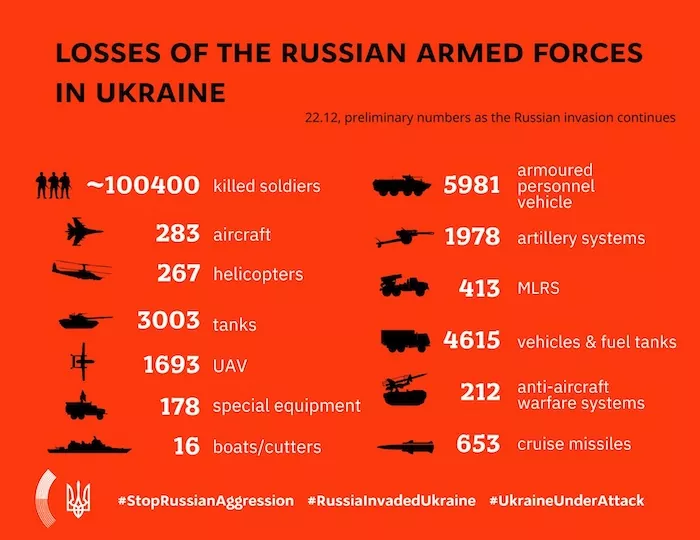
Humanitarian
One in four Ukrainians at risk of mental disorder due to war – WHO, Ukrinform reports, citing Reuters. "WHO estimates that up to 10 million people are at risk of some form of a mental disorder, varying from anxiety and stress to more severe conditions, said Jarno Habicht, WHO's representative in Ukraine. More severe conditions include post-traumatic stress disorder (PTSD) caused by distressing events.
Cases are rising after ten months of war, prompting a separate UN agency to launch online support services. According to the report, Ukraine's healthcare system has been under pressure since Russia invaded in February.
According to the WHO, so far, there have been at least 700 attacks on the country's healthcare system, and Russia's increase in attacks on critical infrastructure since October has added to the challenges by causing blackouts.”
The situation in central Ukraine remains difficult, each oblast receives electricity limits, Ukrainska Pravda reports, citing the press service of Ukrenergo national energy company. “As of the morning of 21 December, there is a significant power shortage in the grid, as well as restrictions caused by damage to the main networks by the systematic missile and drone attacks, the statement reads.
In this regard, power consumption limits have been brought to all oblasts, the exceeding of which will lead to the application of emergency outages. Ukrenergo also added that all types of power generation are currently working. However, the situation in the central area, especially in the city of Kyiv, is still difficult.”
The worst situation with electricity in Kyiv, 60% of transformers do not work, Ukrainska Pravda reports, citing Serhiy Kovalenko, CEO of energy supplier YASNO. "There are no changes for the better. Today, the supply situation in Kyiv is the most difficult in the country. There are areas supplied with electricity for about five hours a day. There are those who have electricity for two or three hours a day. And there are those who have been without electricity at all since the last shelling.
The city cannot get power from the country's power grid due to damage to high-voltage equipment. […] The key problem in Kyiv now is not generation, but networks said a representative of YASNO. The network can't work when 60% of Transformers are out of service. It is impossible to supply electricity to places where there is no equipment, Kovalenko explained.
Could it be better than now? Maybe when the repair work is completed and when the restoration scheme works. Could it be worse? Yes, if we are shelled again. More precisely, if they damage 40% of the nodes that remain."
Environmental
On the darkest day of the year, iconic locations worldwide are going dark to #LightUpUkraine
This is part of $10m fundraising drive for generators for Ukrainian hospitals suffering from blackouts from Russian missile strikes https://t.co/uP3LMk20JI pic.twitter.com/2XwgGB5rdK
— Euromaidan Press (@EuromaidanPress) December 21, 2022
Talks with IAEA chief on Zaporizhzhia plant to be held in Moscow on December 22 — envoy, TASS reports. “Negotiations with International Atomic Energy Agency (IAEA) Director General Rafael Grossi are expected to take place in Moscow on December 22, Russian Permanent Representative to International Organizations in Vienna Mikhail Ulyanov said at a briefing on Wednesday. [..]
According to Ulyanov, the negotiations will focus on the creation of a nuclear and physical security zone at the Zaporozhye Nuclear Power Plant. The process is halfheartedly underway but tomorrow, I think, it will be possible to clarify some points, the Russian envoy noted.
Ulyanov added that Russia would be represented by an inter-agency delegation of officials from the Foreign Ministry, the Rosatom State Nuclear Energy Corporation, the Defense Ministry, the Russian National Guard and the Federal Service for the Supervision of Environment, Technology and Nuclear Management. We’ll see how the consultations end, the envoy said.”
A safety zone around ZNPP will require mechanisms to monitor the situation — envoy, TASS reports. “The establishment of a safety zone around the Zaporizhzhia nuclear power plant will require serious mechanisms to monitor the situation at the site, Russia’s envoy to the international organizations in Vienna, Mikhail Ulyanov, said on Wednesday.
If a protection zone around the ZNPP is established, it will be needed, as part of it, to provide for something more serious in terms of compliance with the agreement to stop [the shelling] and monitor the situation," he said at a news conference.
According to the diplomat, the possible implementation of the IAEA proposal for the presence of the organization's experts at Ukrainian nuclear power plants will not harm Russia's interests in any way.”
Legal
#Russia sentences young #Ukrainian to 12 years on surreal charges of ‘state treason’ #Ukraine #LetMyPeopleGo #FreePetrushyn #Yatskin #StandWithUkraine #StopRussia #Crimeahttps://t.co/6FZtZ2cZc8 pic.twitter.com/6vi62hxslA
— Halya Coynash (@halyapuff) December 21, 2022
Mass grave of Russian-killed people found in Kherson Oblast, Ukrainska Pravda reports. “Oleksii Reznikov, the Defence Minister of Ukraine, reported that a mass grave of victims of Russian invaders had been found in the village of Pravdyne, located in the liberated part of Kherson Oblast.
On 30 November, in the village of Pravdyne (Kherson Oblast), a mass burial of victims of the Russian occupation was discovered: seven civilians, including a teenage girl."
https://twitter.com/ZarinaZabrisky/status/1599110806138163200
Support
US new $1.85 bn aid package to Ukraine includes first-ever Patriot air defense system - 1 battery
A Patriot missile battery includes eight launchers. Patriots can shoot down ballistic missiles, which is a capability Ukraine's air defense currently lacks https://t.co/ZfiTwgZ5DV
— Euromaidan Press (@EuromaidanPress) December 21, 2022
$1.85 Billion in Additional Security Assistance for Ukraine, a statement from the US Department of Defense reads. “On December 21, as part of President Zelenskyy's visit to the White House, the Department of Defense (DoD) announced $1.85 billion in additional security assistance for Ukraine. This includes the authorization of a Presidential Drawdown of security assistance valued at up to $1 billion, as well as $850 million in assistance via the Ukraine Security Assistance Initiative (USAI).
https://twitter.com/EuromaidanPress/status/1605651585199226881
The Presidential Drawdown is the twenty-eighth such drawdown of equipment from DoD inventories for Ukraine that the Biden Administration has authorized since August 2021. Capabilities in this package include:
- One Patriot air defense battery and munitions;
- Additional ammunition for High Mobility Artillery Rocket Systems (HIMARS);
- 500 precision-guided 155mm artillery rounds;
- 10 120mm mortar systems and 10,000 120mm mortar rounds;
- 10 82mm mortar systems;
- 10 60mm mortar systems;
- 37 Cougar Mine Resistant Ambush Protected (MRAP) Vehicles;
- 120 High Mobility Multipurpose Wheeled Vehicles (HMMWVs);
- Six armored utility trucks;
- High-speed Anti-radiation missiles (HARMs);
- Precision aerial munitions;
- Over 2,700 grenade launchers and small arms;
- Claymore anti-personnel munitions;
- Demolition munitions and equipment;
- Night vision devices and optics;
- Tactical secure communications systems;
- Body armor and other field equipment.
Under USAI, the DoD will also provide Ukraine with:
- 45,000 152mm artillery rounds;
- 20,000 122mm artillery rounds;
- 50,000 122mm GRAD rockets;
- 100,000 rounds of 125mm tank ammunition;
- SATCOM terminals and services;
- Funding for training, maintenance, and sustainment.
Unlike Presidential Drawdown, USAI is an authority under which the United States procures capabilities from industry rather than delivering equipment that is drawn down from DoD stocks. This announcement represents the beginning of a contracting process to provide additional capabilities to Ukraine's Armed Forces.
Russia's unrelenting and brutal air attacks against critical infrastructure have only reinforced the need to provide Ukraine with sophisticated air defense capabilities. At President Biden's direction, the United States has prioritized the provision of air defense systems to help Ukraine defend its people from Russian aggression. The Patriot air defense system in this security assistance package is one of the world's most advanced air defense capabilities. Once operational, it will add to a layered defense to counter the full range of threats currently menacing Ukraine's cities and civilians. The Patriot system will augment previous air defense capabilities the United States has provided Ukraine, which include NASAMs, missiles for HAWK air defense systems, Stingers, and equipment to counter the Russian use of unmanned aerial vehicles.
In total, the United States has now committed more than $21.9 billion in security assistance to Ukraine since the beginning of the Biden Administration. Since 2014, the United States has committed approximately $24 billion in security assistance to Ukraine and approximately $21.2 billion since the beginning of Russia's unprovoked, full-scale invasion on February 24. Through PDA and USAI, DoD continues to work with Ukraine to meet both its immediate as well as its longer-term security assistance needs.”
Congress Proposes More Than $44 Billion for Ukraine, The New York Times reports. “The giant annual spending bill unveiled by Congress on Tuesday contains more than $44 billion in emergency aid for Ukraine, renewing the US commitment to the country’s defense as Russia’s invasion grinds toward a second year. The new wave of aid for Ukraine — billions more than President Biden requested in mid-November — comes amid growing concerns among the country’s backers about the depth of America’s support. Some Republicans have questioned the massive spending, while some progressives have called for peace talks.
The aid package consists mostly of military spending, including nearly $20 billion to arm and equip Ukraine’s forces, and to replenish Defense Department stockpiles from which weapons are being sent to Kyiv. Some of that money would also be used to bolster the defenses of America’s NATO allies to protect against further Russian aggression.
Another $6.2 billion would support a surge of US forces in Eastern Europe that Mr. Biden ordered after the Russian invasion, including thousands of American troops deployed to Poland and Romania.
The “omnibus” budget bill, which includes the new Ukraine aid, funds the federal government into next year to avoid a shutdown. If Congress passes it, US aid to Kyiv since Russia invaded in February will amount to more than $100 billion, allocated over four emergency spending packages. Congressional leaders hope to win approval for the spending this week.
Biden task force investigating how US tech ends up in Iranian attack drones used against Ukraine, CNN reports. “The Biden administration has launched an expansive task force to investigate how US and western components, including American-made microelectronics, are ending up in Iranian-made drones Russia is launching by the hundreds into Ukraine, multiple officials familiar with the effort tell CNN. The US has imposed tough export control restrictions and sanctions to prevent Iran from obtaining high-end materials, but evidence has emerged that suggests Iran is finding an abundance of commercially-available technology.
Last month, the UK-based investigative organization Conflict Armament Research examined several drones that had been downed in Ukraine and found that 82% of their components were manufactured by companies based in the US. […]
Their apparently unintentional ensnarement in Iran’s drone manufacturing industry underscores how inexpensive products intended for civilian use can be easily retrofitted for military purposes, and often fall just outside the bounds of sanctions and export control regimes. […]
Conflict Armament Research found that the Iranian drones they examined in Ukraine in November had “higher-end technological capabilities,” including tactical-grade sensors and semiconductors sourced outside of Iran, demonstrating that Tehran has been able to circumvent current sanction regimes and has added more capabilities and resiliency to its weapons.”
Iceland transfers about 12,000 pieces of winter clothing to Ukrainian Armed Forces, Ukrinform reports. “Iceland has provided assistance to the Ukrainian Armed Forces -- about 12,000 pieces of winter clothing, including merino wool socks and sweaters, hats, winter gloves, shoes and outerwear.”
New Developments
- Your money is not charity, It’s an investment – Zelensky, The New York Times ” The decisions of Congress, Zelensky said, can save Ukraine. Let these decisions be taken, he says, pivoting from a message of thanks to a plea to approve the new round of nearly $50 billion for Ukraine. Zelensky warns that if Russia is not defeated in Ukraine, it is bound to come soon for other US allies in Europe. Many US officials and Russia analysts hold this conviction. Your money is not charity, Zelensky says. It’s an investment.”
- Ukrainian soldiers can operate US tanks and warplanes perfectly - Zelensky to US Congress, Ukrinform “The United States can significantly speed up Ukraine's victory in the war with Russia by boosting the supply of a range of military equipment to Ukraine. He emphasized that Ukraine never asked the American soldiers to fight on our land instead of us. I assure you that Ukrainian soldiers can perfectly operate American tanks and planes themselves. Our lack of armoured vehicles and aviation prolongs this war and allows Russia to kill our people, to keep the occupied cities and villages of Ukraine in totalitarian conditions, Zelensky said. He added that only Russia could stop its aggression if it wanted to but YOU can speed up our victory.”
- Ukrainian delegation will ask for ATACMS in the USA, Ukrainska Pravda reports, citing Politico. "During the meeting with Biden and his national security team, the Ukrainian delegation is expected to make another round of pleas for long-range Army Tactical Missile Systems, or ATACMS, and Grey Eagle and Reaper drones, according to a person familiar with the discussions. It is noted that US officials are not ready to budge when it comes to this topic. The White House also categorically refuses to send ATACMS.”
- Zelensky sees a just peace as no compromises on Ukraine’s territorial integrity and sovereignty, Ukrinform “What is just peace? It is a philosophical question. Can we talk about just war? I think, for all of us, just peace is different. What is it for me as the President? No compromises on our land, territorial integrity, our sovereignty,” Zelensky said.In his words, just peace provides for the reimbursement of all the damage caused by Russian armed aggression. At the same time, the President of Ukraine believes there can be no just peace for those parents who have lost their son or daughter on the front.”
- Zelensky's ‘Hollywood-style’ US visit a ‘proxy war’ promotion – Moscow, the Russian propaganda outlet RT “Russia’s ambassador to the US, Anatoly Antonov, has accused Washington of waging a “proxy war” against Moscow, saying that all the statements and declarations made during Ukrainian President Vladimir Zelensky’s visit only further prove that the Biden administration is not interested in a peaceful settlement. Washington is throwing all its colossal resources, weapons, and intelligence capabilities at Kiev in pursuit of the “manic idea of defeating the Russians on the battlefield, Antonov said.”
- Putin has said he has no regrets about launching what he calls his "special military operation", arguing Russia had no choice but to stand up to arrogant Western powers, Reuters “On Wednesday he said he still considered Ukrainians - who have been killed in their tens of thousands, forced to flee in their millions, and seen whole towns and cities destroyed - to be a "brotherly" people. What is happening is of course a tragedy, our common tragedy, but it is not a result of our policy, Putin said. On the contrary, it's the result of the policy of other countries, third countries, who have always striven for this, the disintegration of the Russian world. To a certain extent, they succeeded, and pushed us to the line where we are now."
- Putin still sees Ukrainians as a fraternal nation, TASS “Russian President Vladimir Putin insists that he still views the Ukrainian people as a fraternal nation. We have nothing to be rebuked for. I am saying this quite responsibly. We have always - and you know my position - considered the Ukrainian people to be a brotherly nation. I still think so, he stressed at an expanded board session of the Defense Ministry on Wednesday.”
- Biden remarks on 300 days of Putin’s war against Ukraine, Ukrinform reports, citing CNN. “Mr President, it’s good to have you back. It’s an honour to be by your side in the united defence against what is a brutal, brutal war waged by Putin. Hard to believe, 300 days going through this, and Putin has waged a brutal assault on the Ukrainians’ right to exist as a nation, and the attack on innocent Ukrainian people for no reason other than to intimidate, Biden stressed. Biden also noted the escalated Russian attacks on Ukraine’s energy and civil infrastructure. In his words, Putin is trying to use winter as a weapon. The President of the United States reassured that Americans, along with European allies, stand with Ukraine.”
- China hopes all parties in the Ukraine crisis maintain restraint -President Xi, Reuters “China hopes all parties in the Ukraine crisis will maintain restraint and resolve security concerns through political means, President Xi Jinping told Dmitry Medvedev, chairman of the United Russia party, during a meeting in Beijing on Wednesday, Chinese state media Xinhua reported.”
- Putin claims to keep developing the nuclear triad as a "sovereignty guarantee" for Russia, Ukrainska Pravda Putin “has claimed that he plans to further develop the combat readiness of the Russian nuclear triad as a sovereignty and territorial integrity guarantee. We will sustain and improve the combat readiness of the nuclear triad. This is the main guarantee for preserving our sovereignty, territorial integrity, strategic parity and the balance of power in the world. This year, the quantity of modern armament in the strategic nuclear forces surpassed 91%."
- Putin says the Russian army must tackle problems it has suffered in Ukraine, Reuters “President Vladimir Putin said on Wednesday that the Russian army must learn from and fix the problems it had suffered in Ukraine, promising to give the military whatever it needed to prosecute a war nearing the end of its 10th month. In a speech to defence chiefs in Moscow, Putin said there were no financial limits on what the government would provide in terms of equipment and hardware.”
- Putin claims Russia wanted to join the civilised world but was not welcomed, Ukrainska Pravda reports, citing RIA Novosti. "We always wanted to be a part of this so-called civilised world. And after the collapse of the USSR, which we allowed with our own hands, it seemed to us that from day to day, we would become part of this so-called civilised world. And as it turned out, we were not expected there, in spite of all our efforts and attempts, [President Putin said]."
- US Congress Plans to Label Russia "Aggressor State" Instead Sponsor of Terrorism, European Pravda “Congressional leadership is working on the rapid introduction of a bill condemning Russia as an "Aggressor State." Still, they do not aim at designating Russia as a state sponsor of terrorism. According to the American outlet The Hill, the designation would provide President Biden new sanctions authorities to target Russian officials. […] The state sponsor of terrorism label would isolate Moscow internationally and compel the US to impose costs on countries engaging with the Kremlin. The Biden administration has rejected that effort, saying it would tie the hands of the US in engaging with Russia generally and box in the administration on any diplomatic efforts to end Russia's war against Ukraine.
On November 21, the NATO Parliamentary Assembly recognised the Russian Federation and its regime as a terrorist state. On November 23, the European Parliament recognised Russia as a state sponsor of terrorism and as a state that "uses means of terrorism."
- Belarus restricts access to parts of the region bordering Ukraine and Russia, Reuters “Belarus issued a ruling on Wednesday temporarily restricting access to parts of the southeastern Gomel region that borders Ukraine and Russia. The government said on its website it would temporarily restrict entry, temporary stay and movement in the border zone within the Loevsky, Braginsky and Khoiniki districts of the Gomel region. Russian forces used Belarus as a launch pad for their abortive attack on the Ukrainian capital Kyiv in February, and there has been growing Russian and Belarusian military activity in recent months.”
- Shoigu wants to form another army on the border due to the accession of Finland and Sweden to NATO, Ukrainska Pravda reports, citing RIA Novosti. “Sergey Shoigu, the Russian Defence Minister, has said that the Russian Federation should create a group of troops on the border with Finland due to the accession of this country and Sweden to NATO.”
- Kremlin refuses to reveal the location of frontline which Putin allegedly "visited", Ukrainska Pravda reports, citing RIA Novosti. “Dmitry Peskov, the Press Secretary of the President of the Russian Federation, refused to disclose the location of the war zone in Ukraine, which, according to the Kremlin, had been recently visited by Vladimir Putin.” On 20 December, the media reported thatPresident Zelenskyy visited the city of Bakhmut, which is the hottest spot on the front. On the same evening, Peskov said that Putin visited the war zone in Ukraine on 16 December, including a headquarters of the Russian armed forces. After Peskov's statement about Putin's visit to the front, investigative journalists found out that he had been in the city of Rostov-on-Don [Russia].
Assessment
- On the war.
The Institute for the Study of War has made the following assessment as of December 21, 2022:
“Ukrainian Counteroffensives Eastern Ukraine: (Eastern Kharkiv Oblast-Western Luhansk Oblast)
Russian forces continued to conduct limited counterattacks to recapture lost territory along the Kreminna-Svatove line on December 21. The Ukrainian General Staff reported that Ukrainian forces repelled Russian assaults near Masyutivka, Kharkiv Oblast (50km northwest of Svatove) and Pidkyuchansk, Luhansk Oblast (8km northwest of Svatove). A Russian milblogger claimed that the capture of Masyutivka is a prerequisite for a Russian advance towards Kupiansk from the northeast. A Russian milblogger claimed that Russian forces conducted an assault near Stelmakhivka (16km northwest of Svatove) and Chervonopopivka (6km north of Kreminna). The Ukrainian General Staff also reported that Ukrainian forces repelled Russian assaults near Dibrova (5km southwest of Kreminna) and Bilohorivka (12km south of Kreminna).
Ukrainian forces reportedly continued counteroffensive operations in the Kreminna area on December 21. Luhansk Oblast Head Serhiy Haidai reported that Ukrainian forces are currently a few kilometers away from reaching Kreminna but that dense mine concentrations in the area are slowing Ukrainian advances. Russian milbloggers posted footage purporting to show the aftermath of Russian forces repelling a Ukrainian assault in the vicinity of Kreminna. Haidai reported that decreasing temperatures have produced conditions more conducive to fighting and that he expects current Ukrainian counteroffensive operations to experience success by the end of the year with the intensified pace of fighting. The Ukrainian General Staff confirmed that Ukrainian forces destroyed Russian ammunition depots near Kadiivka (60km southeast of Kreminna) on December 15 and 16.
Russian President Vladimir Putin and Russian Defense Minister Sergey Shoigu presided over a Russian Ministry of Defense (MoD) Collegium in Moscow on December 21 and made significant statements pertaining to Russia’s ongoing invasion of Ukraine and the strategic direction of the Russian military.
The Kremlin intensified its information operation accusing NATO expansion of presenting a military threat to Russia. Shoigu stated that NATO’s military expansion near Russian borders, including Finland’s and Sweden’s NATO membership aspirations, necessitates an "appropriate" Russian response to establish a Russian force group in northwestern Russia. Senior Kremlin officials said that the accession of the Nordic states to NATO would not threaten Russia in spring 2022. Kremlin Spokesman Dmitry Peskov stated that Finland and Sweden joining NATO would not present an existential threat to Russia in April 2022 and Russian Foreign Minister Sergei Lavrov stated that Finland and Sweden joining NATO would not make "much difference" in May 2022.
Shoigu publicly presented a series of proposed Russian defense policy changes to significantly increase the size of the Russian military. Shoigu proposed that Russia reestablish the Moscow and Leningrad military districts, form a new army corps, and form 17 new maneuver divisions. Shoigu suggested that Russia form a new army corps in Karelia, two new airborne assault divisions, three new motorized rifle divisions in occupied Kherson and Zaporizhzhia oblasts, and expand seven existing brigades of the Northern Fleet and Western, Central, and Eastern Military districts into seven new motorized rifle divisions while expanding five existing naval infantry brigades into five naval infantry divisions. Shoigu also proposed that Russia form five artillery divisions to support military districts. He proposed increasing the strength of the Russian Armed Forces to 1.5 million servicemen, including 695,000 contract servicemen (Shoigu said in spring 2021 that 380,000 Russians were contract servicemen), gradually increasing the age of conscription for military service from 18 to 21 years and raising the age limit for conscripts from 27 to 30 years. Shoigu did not specify a timeline for these measures.
This is not the first time the Russian MoD has signaled its intention to reverse the 2008 Serdyukov reforms that largely disbanded Russian ground forces divisions in favor of independent brigades. The Russian MoD has been steadily reversing the Serdyukov reforms by restoring maneuver divisions across Russian military districts since 2013.
The Kremlin is very unlikely to form such a large conventional force in a timeline that is relevant for Russia’s war in Ukraine, however. Forming divisions is costly and takes time. It took the Russian military over a year to reform the 150th Motorized Rifle Division (8th Combined Arms Army) between 2016 and 2017, for example. Russia was unable to fully staff its existing brigades and regiments before the full-scale invasion and had not fully built out a new division it announced it was forming in 2020 before the start of the 2022 invasion of Ukraine. Russia’s economy is in recession, and its resources to generate divisions have significantly decreased since Russia’s full-scale invasion of Ukraine. Russia’s net training capacity has likely decreased since February 24, in part because the Kremlin deployed training elements to participate in combat in Ukraine and these training elements reportedly took causalities. Russia is reportedly leveraging Belarusian trainers to train mobilized forces and possibly contract soldiers and conscripts, indicating the limitations of Russian training bandwidth. Russia’s officer corps has been eviscerated by casualties in this war.
Shoigu’s proposals could be an overture to placate the milblogger community who have accused the Kremlin of not conducting the war seriously or taking the measures necessary to win the war. It also sets information conditions for the Kremlin to conduct future mobilization waves under the rubric of staffing these formations and/or significantly augmenting Russia’s military strength in the long run.
The Kremlin can form a large conventional military along the lines Shoigu described that would be capable of posing a renewed and serious threat to NATO if Russian President Vladimir Putin decides to fundamentally change Russia’s strategic resource allocation over the long run. Putin directly addressed Shoigu and the Chief of the General Staff Valery Gerasimov stating that Russia has no financial limitations and must provide everything the Russian Armed Forces request. While Russia is unlikely to reform large divisions while continuing its invasion of Ukraine, Russia’s military defeats in Ukraine may persuade Putin to change Russia’s strategic resource allocation for the Russian military. Putin can decide to appropriate Russian state funds in such a manner that allows the Kremlin to field a large conventional military at the expense of economic growth and consumer comforts as the Soviets did. Such a course of action would cost resources and time but is possible. Shoigu’s "recommendations," which he certainly presented to Putin privately before describing them publicly, along with Putin’s commitment to providing the Russian military with everything it needs and a number of other indicators suggest that Putin may have already decided to reconstitute a significant conventional Russian military threat to Europe once this war ends.
Putin and Shoigu demonstrated that Russia is not interested in reducing its war efforts or its war aims, despite the growing toll on Russian society. Putin reiterated that Russia will ensure the safety of all Russian territories including illegally-annexed territories in Ukraine while at the MoD Collegium. Putin and Shoigu repeatedly rejected the idea of independent Ukrainian sovereignty and emphasized Russia’s need to keep Ukraine within the Kremlin’s sphere of influence and defeat the Ukrainian "Nazi" regime. Putin and Shoigu’s comments further illustrate that the Kremlin retains maximalist goals for the war in Ukraine that include: the recognition of illegally annexed territories, regime change of the Ukrainian government under the pretext of "denazification," control of Ukraine’s political and social character, and Western granting of Russia’s desired "security guarantees."
The reiteration of Putin’s February 24 goals indicates that the Kremlin is deciding to embrace the sacrifices of the war and attempt to push on to victory. The Kremlin will need to continue to ask for and justify great sacrifices from its people to pursue these unrealistic goals. Shoigu attempted to justify the societal cost of mobilization, acknowledging that mobilization was "a serious test" for Russian society necessary to defend newly acquired territories in Ukraine. Putin likely believes that if he downscaled his maximalist set of goals or defined lesser short-term objectives he would incur widespread discontent from both the wider Russian public and the ultra-nationalist pro-war community for committing Russia to a costly war in pursuit of an inadequate reward. The Kremlin will likely continue to reiterate maximalist goals as it demands further sacrifices from the Russian public to support the war effort, whether through new force generation efforts, imposing the continued long-term economic impacts of international sanctions regimes, extracting from the populace the cost of rebuilding a powerful Russian military, or forcing the Russian people to continue to accept heavy Russian casualties in Ukraine.
Putin and Shoigu maintained the Kremlin’s information operation that seeks to coerce the West into pushing Ukraine to negotiate on Russia’s terms. Shoigu claimed during his speech that the Kremlin is always open to holding constructive, peaceful negotiations. Putin and Shoigu likely reiterated Russian maximalist goals at the Russian MoD Collegium at a time when Ukrainian officials are discussing the possibility of a renewed Russian large-scale offensive in the winter of 2023 and voices are rising in the West calling for Ukraine to initiate negotiations with Moscow to add further pressure on Ukraine to negotiate on Russian terms. The Kremlin likely believes that it will be able to exact more preemptive concessions from Ukraine the more maximalist its stated goals for the war are as it also prepares what it is presenting as another large-scale offensive operation. The Kremlin’s effort to coerce Ukraine into negotiating or offering preemptive concessions is increasingly divorced from the battlefield reality in Ukraine where Ukrainian forces retain the initiative.
Putin significantly intensified his efforts to make peace with the critical pro-war community in the past 48 hours. Putin admitted at the MoD collegium meeting that Russian forces had faced challenges with mobilization, lack of drones and new equipment, and signals. Shoigu acknowledged similar concerns echoing criticism from prominent Russian milbloggers for 10 months of the war. Putin then asked the Russian MoD "to be attentive" to all criticism and "hear those who do not hush up the existing problems," noting that the ministry will be in constant dialogue with such critics.
Putin also established a working group on December 20 that will address issues with mobilization and offer social and legal support for participants of the "special military operation," empowering some milbloggers. Putin recruited several prominent milbloggers such as Mikhail Zvinchuk from Rybar, Evgeniy Poddubny, and Alexander Sladkov among others, as well as some state officials to compile a monthly report to be delivered directly to Putin. The working group has the authority to make proposals and review mobilization concerns. […]
Putin may also attempt to recruit additional milbloggers from other nationalist factions in the information space. Putin’s mobilization group notably did not include figures closely affiliated with the Wagner Group or Chechen leader Ramzan Kadyrov, and instead targeted a group that has already gained some prominence on Russian state outlets. Putin has notably refrained from giving Wagner Group financier Yevgeniy Prigozhin an official position within the Russian government even though Prigozhin supposedly directly reports on Russia’s military failures to Putin and is contributing his forces to Putin’s war. Prigozhin remains simply the de facto head of a nominally illegal mercenary group even as milbloggers secure formal, if sometimes ad hoc, official positions.
Putin’s ability to sustain his narrative is vulnerable to his inability to deliver on his maximalist goals and promises in the long run. Putin and Shoigu assured the collegium that Russia will learn from the mistakes of the "special military operation" and promised to implement several changes to remedy problems within the war effort. Russia, however, is unlikely to efficiently address the fundamental flaws of its military structure—certainly not in any short period of time—and that failure will likely revitalize criticism. Putin will also need to continue to deflect blame from himself for failing to deliver on such promises onto the Russian MoD without destroying the credibility of the MoD and the uniformed military in the eyes of the Russian population. Putin’s consistent appeasement of the milbloggers demonstrates that he recognizes their influence on the Russian people of whom he asks such tremendous sacrifices to sustain his war effort.
Putin and Shoigu continued to use descriptions of heightened nuclear readiness to appease domestic nationalist audiences and intimidate Western audiences without enunciating new policies or any fundamental changes in Russia’s nuclear posture or capabilities. Putin stated that Russian forces will continue to develop Russia’s nuclear triad as the main guarantor of Russian sovereignty and territorial integrity. Putin and Shoigu claimed that modern weapons compose 91.3% of Russia’s strategic nuclear arsenal, that Russian forces are fielding Avangard hypersonic warheads, and that Russian forces will soon introduce Sarmat intercontinental ballistic missiles into active service.
Such descriptions are extremely unlikely to represent enhanced Russian willingness to use nuclear weapons. The Kremlin routinely uses nuclear rhetoric to project strength to the far-right Russian community, which has accused the Russian Ministry of Defense (MoD) of failing to take sufficiently aggressive steps to support the war in Ukraine and to demand that the West reduce its "escalatory" provision of aid to Ukraine and to pursue negotiations on Russian terms by hinting at the possibility of nuclear escalation. ISW has extensively reported on previous incidents in which Russian officials have referred to nuclear weapons to influence Western and domestic audiences and assessed that Russian officials have no intention of actually using nuclear weapons on the battlefield] […]
Key Takeaways
- Russian Defense Minister Sergey Shoigu proposed a series of expansive reforms and goals for Russian force generation that Russia is highly unlikely to complete in time to be relevant to the current conflict.
- Putin and Shoigu reiterated maximalist Russian aims for the war in Ukraine.
- Russian President Vladimir Putin has intensified efforts to make peace with the critical pro-war nationalist community. Russian failures to achieve Putin’s stated goals jeopardize Kremlin efforts to regain control over the domestic narrative and to set conditions for the second [tenth] year of the war.
- Russian nuclear rhetoric is most likely an attempt to appease domestic audiences and intimidate Western audiences and not an indicator of preparation to use nuclear weapons.
- Ukrainian President Volodymyr Zelensky traveled to Washington, DC on December 21. […]
- Russian and Ukrainian forces continued counterattacks along the Svatove-Kreminna line.
- Russian forces continued offensive operations in the Bakhmut and Donetsk City areas.
- A Ukrainian official confirmed that Russian forces unsuccessfully attempted to establish control over the Dnipro delta islands.
- Russian Defense Minister Sergei Shoigu boasted about the growing Russian Young Army Cadets National Movement (Yunarmia) movement.
Russian officials intensified law enforcement crackdowns to deter partisan activities and target partisan sympathizers.“
NSDC Secretary: Ukraine expects that the coming months will be decisive in the war, Ukrinform reports, citing the Secretary of the National Security and Defense Council of Ukraine, Oleksiy Danilov, in an interview with Voice of America. “We realize that, as of today, Russia has no capabilities to defeat us in an open battle. They are now driven to a dead end. The rat backed into a corner is the most dangerous. We are actively preparing for the next one-two-three months which can be decisive in this regard. Now, the Russian Federation, considering that it does not want to accept the position of the entire global community and realizes that it should retreat as soon as now to minimize effects directly for its own state, will continue to go, as they have put everything at stake, Danilov said.
In his words, Ukraine understands all the challenges and prepares for them as much as possible, but support from international partners is absolutely necessary. […] We understand that we are defending not only ourselves. We are defending the whole of Europe against this invasion, Danilov added.”
Russian private military company might simulate shelling of Belarus by Ukraine – National Resistance Center, Ukrainska Pravda reports, citing the : National Resistance Center (NRC). “Mercenaries of the Liga PMC, a part of the Wagner Group, arrived at the northern border of Ukraine to prepare a provocation. They are probably planning to simulate the shelling of Belarus by the Armed Forces of Ukraine.
According to the Center, the mercenaries have been divided into two groups (80-90 people) and arrived near the village of Krupiejki in the Lójeŭski Raion of the Homiel Oblast. The groups have lightly armoured vehicles and awning trucks at their disposal. The groups are reinforced by engineering units. Meanwhile, Belarus introduced a temporary restriction on entry and re-entry within the border strip of the Lójeŭski district, the Center emphasises.
The NRC believes that one of the scenarios of the provocation is a shelling of the territory of Belarus, allegedly by the Armed Forces of Ukraine.”
- Consequences and what to do?
Almost 80% of citizens are optimistic about the future of Ukraine, Ukrainska Pravda reports, citing a survey by the KIIS. “According to a survey conducted by the Kyiv International Institute of Sociology (KIIS), 78.5% of Ukrainian citizens are optimistic about the future of Ukraine.
According to the survey, despite the full-scale war and the social, economic and energy problems caused by it, 78.5% of respondents are optimistic about the future of Ukraine, and 88% about the future of their hromada [an administrative unit designating a town, village or several villages and their adjacent territories].”
Hans Petter Midttun: Today’s assessment will be published as a separate article. A teaser:
“Nearly nine years after the war started – and nine years of sanctions – it is probably fair to state that the West has failed to impose its will on Russia. In my opinion, NATO and the EU have achieved the opposite. A low-intensity war has escalated into a full-scale war.
There are several reasons for its failure to force Russia to withdraw and act according to international law.
Firstly, Russia sees negotiations as a sign of weakness, not strength. The fact that the West stands united behind the sanctions only demonstrates collective weakness and lack of will and ability to do what is needed to end the war.
Secondly, sanctions are temporary. In contrast to the massive destruction in Ukraine, sanctions do not destroy anything. They only temporarily cut the flow of money.
Russia will live with the temporary pain to secure future gains.
Which is the third reason for sanctions not working. While the pains from sanctions are temporary, Russia stands to gain enormously from a victory in Ukraine.”
The article elaborates.



